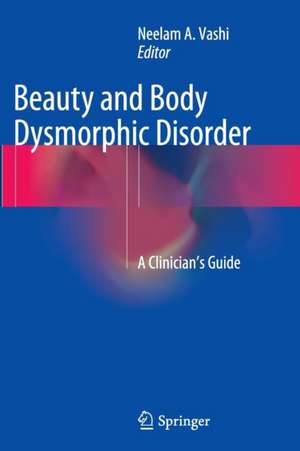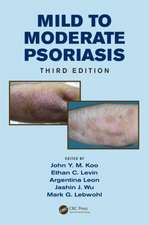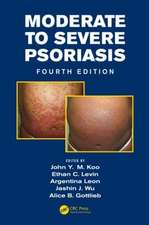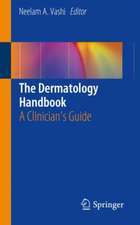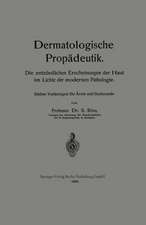Beauty and Body Dysmorphic Disorder: A Clinician's Guide
Editat de Neelam A. Vashien Limba Engleză Paperback – 22 oct 2016
While an element of dissatisfaction with one’s appearance is commonplace, clinicians should remain vigilant for individuals who seek cosmetic procedures to quell excessive body image concerns that are out of proportion to objective physical findings. Body dysmorphic disorder (BDD) is a disorder of self-perception; it is the impairing preoccupation with a nonexistent or minimal flaw in appearance. According to recent statistics, BDD occurs in 0.7–2.4% of the general population; however, multiple studies have suggested an incidence of 6–16% in patients seeking aesthetic medical treatments. Moreover, a vast majority will at some point seek dermatologic treatment and cosmetic surgery. Such patients are unlikely to be satisfied with corrective procedures, and only 15% of dermatologists surveyed thought that they could successfully treat BDD. Therefore, Beauty and Body Dysmor
phic Disorder aims to assist dermatologists, plastic surgeons, and other aesthetic providers in recognizing key characteristics as well as providing treatment strategies to help in caring for those with BDD.
| Toate formatele și edițiile | Preț | Express |
|---|---|---|
| Paperback (1) | 705.48 lei 6-8 săpt. | |
| Springer International Publishing – 22 oct 2016 | 705.48 lei 6-8 săpt. | |
| Hardback (1) | 718.65 lei 6-8 săpt. | |
| Springer International Publishing – 14 sep 2015 | 718.65 lei 6-8 săpt. |
Preț: 705.48 lei
Preț vechi: 742.61 lei
-5% Nou
Puncte Express: 1058
Preț estimativ în valută:
135.04€ • 146.73$ • 113.50£
135.04€ • 146.73$ • 113.50£
Carte tipărită la comandă
Livrare economică 21 aprilie-05 mai
Preluare comenzi: 021 569.72.76
Specificații
ISBN-13: 9783319361987
ISBN-10: 3319361988
Pagini: 210
Ilustrații: X, 210 p. 43 illus., 27 illus. in color.
Dimensiuni: 155 x 235 mm
Greutate: 0.32 kg
Ediția:Softcover reprint of the original 1st ed. 2015
Editura: Springer International Publishing
Colecția Springer
Locul publicării:Cham, Switzerland
ISBN-10: 3319361988
Pagini: 210
Ilustrații: X, 210 p. 43 illus., 27 illus. in color.
Dimensiuni: 155 x 235 mm
Greutate: 0.32 kg
Ediția:Softcover reprint of the original 1st ed. 2015
Editura: Springer International Publishing
Colecția Springer
Locul publicării:Cham, Switzerland
Cuprins
Chapter 1: Historical Importance of Beauty; Chapter 4: Subjective Aspects of Beauty; Chapter 6: Body Dysmorphic Disorder: Historical Aspects; Chapter 7: Diagnosis of Body Dysmorphic Disorder; Chapter 8: Body Dysmorphic Disorder: Etiology and Pathophysiology; Chapter 9: Body Dysmorphic Disorder: Epidemiology and Specific Cohorts; Chapter 10: Body Dysmorphic Disorder: Effects of Aesthetic Treatments and Implications for the Dermatologist and Cosmetic Surgeon; Chapter 11: Body Dysmorphic Disorder: Screening Patients and Associated Algorithms; Chapter 12: Therapeutic Interventions for Body Dysmorphic Disorder; Chapter 13: Prognosis and the Effect of Body Dysmorphic Disorder on Life; Chapter 14: Approach and Resources.
Notă biografică
Neelam A. Vashi, MD, FAAD is a board certified dermatologist and a fellow of the American Academy of Dermatology. She is an Assistant Professor of Dermatology at the Boston University (BU) School of Medicine and teaches dermatology to BU residents, international trainees, and medical students. She is also the Director of Research in Cosmetic and Laser Medicine and the Founder and Director of the Boston University Center for Ethnic Skin. Dr. Vashi received her medical degree from Northwestern University Feinberg School of Medicine, where she was inducted into the Alpha Omega Alpha Honor Medical Society. After her internship in internal medicine at Northwestern University, Dr. Vashi completed her dermatology residency at New York University (NYU) in the Ronald O. Perelman Department of Dermatology. Dr. Vashi is a recognized leader in medical and cosmetic dermatology and in patients with skin of color. She is widely published in the peer-reviewed literature, author of several book chapters, and is a frequent lecturer at both national and international dermatology meetings.
Textul de pe ultima copertă
Over the decades, research has demonstrated that in categories of life deemed to be important, beautiful people achieve more desirable outcomes, are judged more favorably, and receive preferential treatment. An understanding of the historical aspects, science, and implications of what the human mind finds aesthetically pleasing is quintessential for dermatologists, plastic surgeons, and others who practice aesthetic medicine as the importance of beauty in today’s society is what brings patients into clinics.
While an element of dissatisfaction with one’s appearance is commonplace, clinicians should remain vigilant for individuals who seek cosmetic procedures to quell excessive body image concerns that are out of proportion to objective physical findings. Body dysmorphic disorder (BDD) is a disorder of self-perception; it is the impairing preoccupation with a nonexistent or minimal flaw in appearance. According to recent statistics, BDD occurs in 0.7–2.4% of the general population; however, multiple studies have suggested an incidence of 6–16% in patients seeking aesthetic medical treatments. Moreover, a vast majority will at some point seek dermatologic treatment and cosmetic surgery. Such patients are unlikely to be satisfied with corrective procedures, and only 15% of dermatologists surveyed thought that they could successfully treat BDD. Therefore, Beauty and Body Dysmor
phic Disorder aims to assist dermatologists, plastic surgeons, and other aesthetic providers in recognizing key characteristics as well as providing treatment strategies to help in caring for those with BDD.
While an element of dissatisfaction with one’s appearance is commonplace, clinicians should remain vigilant for individuals who seek cosmetic procedures to quell excessive body image concerns that are out of proportion to objective physical findings. Body dysmorphic disorder (BDD) is a disorder of self-perception; it is the impairing preoccupation with a nonexistent or minimal flaw in appearance. According to recent statistics, BDD occurs in 0.7–2.4% of the general population; however, multiple studies have suggested an incidence of 6–16% in patients seeking aesthetic medical treatments. Moreover, a vast majority will at some point seek dermatologic treatment and cosmetic surgery. Such patients are unlikely to be satisfied with corrective procedures, and only 15% of dermatologists surveyed thought that they could successfully treat BDD. Therefore, Beauty and Body Dysmor
phic Disorder aims to assist dermatologists, plastic surgeons, and other aesthetic providers in recognizing key characteristics as well as providing treatment strategies to help in caring for those with BDD.
Caracteristici
Discusses body dysmophic disorder as it relates to the objective and subjective aspects of beauty Provides dermatologists with information that will help them treat those afflicted with body dysmorphia Discusses how to spot the signs in current and potential patients Topics covered include the historical importance of beauty, body image and body image dissatisfaction, case studies, etiology of body dysmorphic disorder, and therapeutic interventions Includes supplementary material: sn.pub/extras
